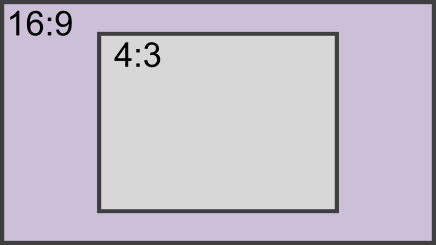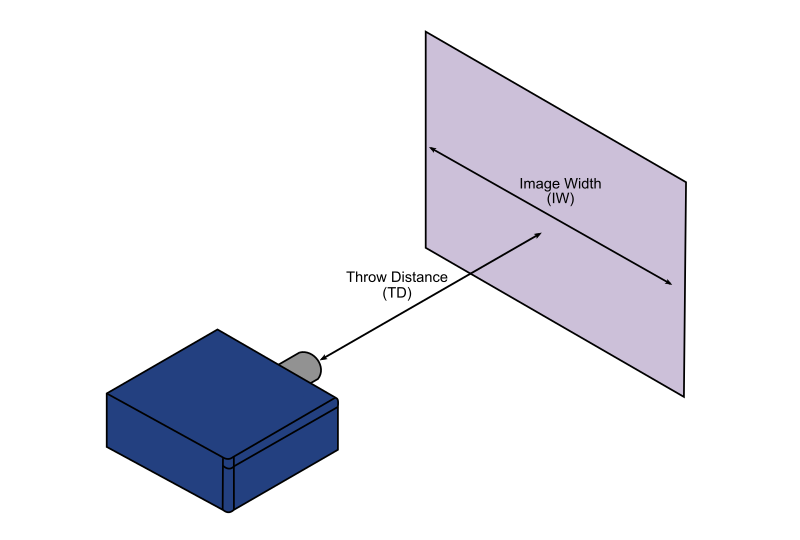Aspect ratio
The first step is to identify the dimensions of the image that you wish to project. The native aspect ratio of the PROPixx projector is 16:9, which means that the PROPixx projects an image whose proportions are 16 units wide by 9 units tall. In other words, it produces an image that is 1.78x wider than it is tall.
The PROPixx can also produce 4:3 and 5:4 aspect ratios, by projecting images on a central subset of the total available pixels. We chose this approach because one pixel of the video input drives one pixel in the projected image, bypassing the pixel artifacts resulting from image scaling and processing. The PROPixx displays unused pixels in black.
While set to its native video mode, the PROPixx projector displays a 16:9 image. It is possible to change the aspect ratio of the image by modifying the display properties in your operating system. For example, presenting the image with a 4:3 aspect ratio will result in a smaller image (grey shading). The unused portions of the original 16:9 screen will display black pixels (coloured outer shading).

In this calculator, you can input your desired image width (in arbitrary units) below to automatically generate the height and diagonal dimensions of the image that is generated by a PROPixx operating in its native 16:9 video mode and aspect ratio.
The corresponding image dimensions of a PROPixx set in 5:4 or 4:3 aspect ratio are also automatically gene
Lens Choice
In contrast to LCD screens or other types of visual displays whose physical dimensions are physically constrained by the imaging mechanism, we can outfit the PROPixx with one of many lenses that can produce a large variety of image sizes.
Two parameters describe if a lens will be compatible with the image dimensions you want to achieve: the focus range and the throw ratio. The focus range refers to the minimal and maximal distances past the PROPixx, where the lens can produce an image that is clear and in focus. A projection screen can be placed anywhere within the focus range. The distance between the screen and the projector is known as the throw distance (TD).
The throw ratio (TR) characterizes the correct lens for your application according to the following equation: TR = TD/IW, where IW is the width of the 16:9 image generated by the PROPixx.

Example #1
A typical scenario is that a researcher wants to use a specific video feature of the PROPixx, but wants to match the dimensions of a visual display used in other research. For example, they might want to match the VIEWPixx/3D screen dimensions, a 16:9 CRT-replacement screen with a fixed 24-inch diagonal. We might want to make the most of a small testing room and place the projection screen as close as possible to the PROPixx, as afforded by the lens's focus range.
Let's assume that our throw distance will be TD = 1.22 m. The image width corresponding to a 16:9 VIEWPixx/3D screen is IW = 0.53 m. The corresponding throw ratio is TR = 1.22 m / 0.53 m = 2.29.
If you look at the list of available lenses on the PROPixx's ordering information page, we find that the VPX-ACC-6503 has a focus range of 1.2 m - 9.75 m (4.0 -32 feet) and a throw ratio range of 1.85-2.4. This lens fits both of our requirements.

Example #2
In other situations, the researcher wants to replicate an older system's dimensions, which employs another aspect ratio, such as a 1024 x 768 4:3 CRT monitor. These displays often measured 0.32 m x 0.24 m, with a 0.4 m (i.e., 15.8 inch) diagonal. However, the image width we will use in our throw ratio calculation will not be 0.32 m. Instead, the correct dimension is the width of the native 16:9 image that the PROPixx generates (see section Aspect Ratio). The width of the native image that produces the desired 4:3 projection is IW = 0.60 m.
The resulting throw ratio is TR = TD/IW = 1.22 m/0.60 m = 2.02.
Therefore, the VPX-ACC-6503 lens is also the correct choice for this example.